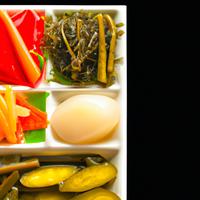
1 serving (50 grams) contains 10 calories, 0.5 grams of protein, 0.0 grams of fat, and 2.0 grams of carbohydrates.

Log this food in SnapCalorie

Nutrition Information
Calories |
47.3 | ||
|---|---|---|---|
% Daily Value* |
|||
| Total Fat | 0 g | 0% | |
| Saturated Fat | 0 g | 0% | |
| Polyunsaturated Fat | 0 g | ||
| Cholesterol | 0 mg | 0% | |
| Sodium | 2365.9 mg | 102% | |
| Total Carbohydrates | 9.5 g | 3% | |
| Dietary Fiber | 2.4 g | 8% | |
| Sugars | 4.7 g | ||
| protein | 2.4 g | 4% | |
| Vitamin D | 0 mcg | 0% | |
| Calcium | 47.3 mg | 3% | |
| Iron | 0.9 mg | 5% | |
| Potassium | 236.6 mg | 5% | |
* Percent Daily Values are based on a 2,000 calorie diet. Your daily values may be higher or lower depending on your calorie needs.
Food Attributes
Source of Calories
About Japanese pickles
Japanese pickles, or "tsukemono," are a staple in Japanese cuisine, offering a flavorful accompaniment to a variety of meals. Typically made by preserving vegetables like cucumbers, daikon, cabbage, or plums in salt, vinegar, soy sauce, or rice bran, they come in a diverse range of textures and tastes—from tangy umeboshi to savory nukazuke. Tsukemono are rich in probiotics when fermented, supporting gut health and digestion. They are generally low in calories and contain beneficial nutrients from the vegetables used, such as fiber and vitamins. However, some varieties can be high in sodium due to their preservation methods, so they should be enjoyed in moderation. These pickles not only provide a nutritional boost but also serve to balance and enhance the flavors in traditional Japanese meals, making them a beloved and healthful element of the cuisine.



